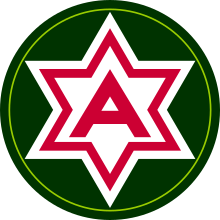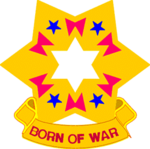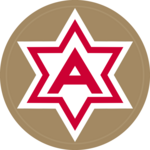Sixth Army (United States)
| Sixth Army | |
|---|---|
 | |
| Active | 1943–1995 2008–present |
| Country | |
| Branch | |
| Type | Theater Army |
| Role | Component command |
| Garrison/HQ | Fort Sam Houston,Texas |
| Nickname(s) | "Alamo Force" |
| Motto(s) | Born of War |
| Engagements | World War II |
| Commanders | |
| Notable commanders | Walter Krueger Joseph Stilwell Albert C. Wedemeyer Robert M. Cannon David E. Grange Jr. William Hardin Harrison |
| Insignia | |
| Flag |  |
| Distinctive unit insignia |  |
| Sixth Army's Shoulder Sleeve Insignia 1927-1945 Saw limited use in WW2 |  |
| Sixth Army's Shoulder Sleeve Insignia during WW2 until the 1950s |  |
| NATO Map Symbol |  |
Sixth Armyis atheater armyof the United States Army. The Army service component command ofUnited States Southern Command,itsarea of responsibilityincludes 31 countries and 15 areas of special sovereignty in Central and South America and the Caribbean. It is headquartered atFort Sam Houston.
The Sixth Army saw extensive service in the South Pacific during World War II, including inNew Britain,New Guinea,and thePhilippines.Postwar it served stateside training army forces until its inactivation during force reduction in 1995. The army was reactivated in 2007.
History[edit]
Interwar period[edit]
The first iteration of the Sixth Army was authorized by theNational Defense Act of 1920and was originally to be composed ofOrganized Reserveunits primarily from the Seventh, Eighth, and NinthCorps Areas.The Headquarters and Headquarters Company were constituted in the Organized Reserve on 15 October 1921 and allotted to the Seventh Corps Area.Little Rock,Arkansas,was designated as the army headquarters upon organization, but the unit was never organized at that location. The Headquarters Company was initiated 13 October 1922 at Little Rock. Little Rock remained the Sixth Army’s headquarters location upon the event of its activation until 25 February 1924 whenSt. Louis,Missouri,was designated as the army’s new headquarters location. The headquarters was initiated in August 1924 at St. Louis. The Headquarters Company was inactivated at Little Rock on 1 October 1924 and relocated to St. Louis. Due to the abandonment of the “Six Army” plan in favor of the “Four Army” plan, the Sixth Army was deleted from the mobilization plans on 1 October 1933 and demobilized (disbanded). Its subordinate units were reassigned to the Fourth Army, the General Headquarters Reserve, or demobilized.[1]
World War II[edit]
The Sixth United States Army was activated in January 1943, commanded by Lieutenant GeneralWalter Krueger.[2]Under the code nameAlamo Force,[3]it assumed control of the majority ofUS Armyunits involved inOperation Cartwheel,the campaign to isolate and neutralize the Japanese base atRabaulinNew Britain.Following the completion of Cartwheel, Sixth Army joined theAustralian Armyand other US forces on the north coast ofNew Guinea.[4]Similar in conception to the island hopping operations of the central Pacific, the object of the attacks was to land, establish a garrison and airfield which could support the next strike, and then move on.
In September 1944, Sixth Army was relieved from operations in New Guinea by theEighth Army.On 20 October 1944,X CorpsandXXIV Corps,under Sixth Army, invadedLeytein thePhilippines.By December, Leyte was secured, and the Sixth Army was relieved again by Eighth Army to prepare for the invasion ofLuzon.[5]As a prelude to that invasion, the island ofMindorowas invaded by theWestern Visayan Task Forcecomprising the19thand503rdRegimental Combat Teams.[6]Sixth Army took part in theInvasion of Lingayen Gulf[7]on 9 January 1945 with the subordinate units ofIandXIV Corps.[8]Sixth Army units fought south until they met up those of Eighth Army advancing from aroundManila.Sixth Army then continued to clear the north of Luzon and confronted theShimbu Groupin theSierra Madresuntil the end of the war. Sixth Army was to have provided the ground forces for the first phase of theinvasion of Japan,[9]though afterJapan's early surrenderSixth Army was reassigned tooccupation dutyin Japan.[10]Sixth Army returned to the United States in 1946, and was headquartered at thePresidio of San Francisco.
After the war, Sixth Army took responsibility for training of Army forces from part of the continental United States. It was eventually inactivated in June 1995 due to force reductions.[11]
Reactivation[edit]
In 2007 it was decided thatUS Army Southwould be redesignated as US Army South (Sixth Army) under theArmy modularization program.[12][13]It is garrisoned at theOld Brooke Army Medical Centerbuilding atFort Sam Houston.[14]
Organization of the army after reformation is as follows:[15]
- United States Army South Headquarters and Headquarters Battalion,Fort Sam Houston, Texas
- 470th Military Intelligence Brigade,Fort Sam Houston, Texas
- 56th Signal Battalion,Fort Sam Houston, Texas
- Army Forces,Honduras(Joint Task Force Bravo),Soto Cano Air Base,Honduras
- Geospatial Planning Cell, 512th Engineer Detachment,Fort Sam Houston, Texas
- 377th Theater Sustainment Command,New Orleans, Louisiana
- 807th Deployment Support Medical Command,Fort Douglas, Utah
- 525th Military Police Battalion,Guantanamo Bay, Cuba
- 1st Battalion,228th Aviation Regiment,Soto Cano Air Base, Honduras
Commanding officers[edit]
- GENWalter Krueger(16 February 1943 – 28 January 1946)
- Inactive (29 January 1946 – 28 February 1946)
- GENJoseph W. Stilwell(1 March 1946 – 12 October 1946)
- MGGeorge Price Hays(13 October 1946 - June 1947)
- GENMark W. Clark(June 1947 – 30 September 1949)
- LTGAlbert C. Wedemeyer(1 October 1949 – 23 June 1951)
- MGMilton B. Halsey(acting) (23 June 1951 – 31 August 1951)
- LTGJoseph M. Swing(1 August 1951–1954)
- LTGWillard G. Wyman(1954–1955)
- LTGRobert N. Young(1955–1957)
- LTGLemuel Mathewson(1957–1958)
- LTGCharles D. Palmer(1958 – 31 August 1959)
- LTGRobert M. Cannon(1 September 1959 – 31 August 1961)
- LTG John L. Ryan (1 September 1961 – 31 July 1963)
- LTGFrederic J. Brown II(1 August 1963 – 31 July 1965)[16]
- LTGJames L. Richardson(1 August 1965 – 1967)[16]
- LTGBen Harrell(1967–1968)
- LTGStanley R. Larsen(1968–1971)
- LTG Alexander D. Surles (1971–1972)
- LTGRichard G. Stilwell(1972–1973)
- LTG Elvy B. Roberts (1973–1975)
- LTG Edward M. Flanagan Jr. (1975–1978)
- LTGEugene Forrester(1978–1980)
- LTG Charles M. Hall (1980–1981)
- LTGDavid E. Grange Jr.(1981–1984)
- LTGRobert Arter(1984–1986)
- LTGFrederick F. Woerner Jr.(1986–1987)
- LTG James E. Moore Jr. (1987–1989)
- LTGWilliam H. Harrison(1989–1991)
- LTGGlynn C. Mallory Jr.(1991–1995)
References[edit]
- ^Clay, Steven E. (2010).U.S. Army Order of Battle, 1919-1941, Volume 1. The Arms: Major Commands and Infantry Organizations, 1919-41.Fort Leavenworth, KS: Combat Studies Institute Press. p. 133.
 This article incorporates text from this source, which is in thepublic domain.
This article incorporates text from this source, which is in thepublic domain.
- ^"U.S. Army Campaigns: WWII - Asiatic-Pacific Theater".Center of Military History.United States Army.19 November 2010.Retrieved11 July2011.
- ^Eustace E. Nabbie (22 September 1993)."The Alamo Scouts"(PDF).Center for the study of intelligence.Central Intelligence Agency.Archived fromthe original(PDF)on 13 February 2008.Retrieved11 July2011.
- ^Cooke, Tim; Adrian Gilbert; Tony Hall; Robert Jackson; Chris McNab; Donald Somerville; Robert Stewart; Ian Westwell (2004).History of World War II.Tarrytown, New York: Marshall Cavendish. p. 383.ISBN978-0-7614-7482-1.Retrieved11 June2011.
- ^"Leyte".Center of Military History.United States Army.3 October 2003. Archived fromthe originalon 9 February 2016.Retrieved11 July2011.
- ^Smith, Robert Ross (1963).Triumph in the Philippines.Government Printing Office. p. 45.ISBN9780160899539.LCCN62-60000.Retrieved11 July2011.
- ^Video: Allied Bombers Strike On Two Fronts Etc (1945).Universal Newsreel.1945.Retrieved21 February2012.
- ^"Luzon 1944 - 1945".Center of Military History.United States Army.3 October 2003. Archived fromthe originalon 15 December 2008.Retrieved11 July2011.
- ^"CHAPTER XIII:" DOWNFALL "THE PLAN FOR THE INVASION OF JAPAN".Center of Military History.United States Army.20 June 2006. Archived fromthe originalon 17 August 2019.Retrieved11 July2011.
- ^"CHAPTER II: TROOP MOVEMENTS, DISPOSITIONS, AND LOCATIONS".Center of Military History.United States Army.11 December 2006. Archived fromthe originalon 18 January 2012.Retrieved11 July2011.
- ^Carl Nolte (24 June 1995)."PAGE ONE -- Troops March From Presidio into History".San Francisco Chronicle.Retrieved11 July2011.
- ^Armies and Corps(PDF)(Map).United States Army.Retrieved21 December2008.
- ^Cavallaro, Gina (9 October 2007)."New name, same mission for U.S. Army South".Army Times.Army Times Publishing Company.Retrieved21 December2008.
- ^"Fort Sam Houston, Texas"(PDF).Base Realignment and Closure.United States Army. 6 March 2007. Archived fromthe original(PDF)on 28 September 2011.Retrieved11 July2011.
- ^"U.S. Army South Organization".arsouth.army.mil.Archived fromthe originalon 21 December 2019.Retrieved19 November2019.
- ^ab"Sixth Army Commander Appointed".San Francisco Examiner.26 June 1965. p. 9 – via Newspapers.
External links[edit]
- List of former commandersof 6th United States Army and United States Army South atUnited States Army Southwebsite
- Sixth U.S. Army
- Fort Ord California
- Born of War... Dedicated to Peace
- The short filmBig Picture: This is Sixth Armyis available for free viewing and download at theInternet Archive.
- A film clipAIR ASSAULT TACTICS [ETC.] (1945)is available for viewing at theInternet Archive

